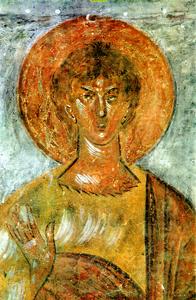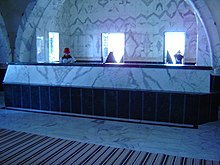Abel
Abel | |
|---|---|
 Icon of Abel by Theophanes the Greek | |
| Born | 71-77 AM |
| Died | 99-105 AM (aged 22-34) |
| Parent | Adam and Eve |
| Relatives | In Genesis: Cain (sibling) Seth (sibling) According to later traditions: Aclima (sibling) Awan (sibling) Azura (sibling) |
Abel[a] is a Biblical figure in the Book of Genesis within Abrahamic religions. He was the younger brother of Cain, and the younger son of Adam and Eve, the first couple in Biblical history.[1] He was a shepherd who offered his firstborn flock up to God as an offering. God accepted his offering but not his brother's. Cain then killed Abel.
According to Genesis, this was the first murder in the history of mankind.
Genesis narrative
Interpretations
Jewish and Christian interpretations
According to the narrative in Genesis, Abel (Template:Lang-he Hébel, in pausa הָבֶל Hā́ḇel; Template:Lang-grc-x-biblical Hábel; Template:Lang-ar, Hābēl) is Eve's second son. His name in Hebrew is composed of the same three consonants as a root meaning "breath". Julius Wellhausen has proposed that the name is independent of the root.[2] Eberhard Schrader had previously put forward the Akkadian (Old Assyrian dialect) ablu ("son") as a more likely etymology.[3]

In Christianity, comparisons are sometimes made between the death of Abel and that of Jesus, the former thus seen as being the first martyr. In Matthew 23:35 Jesus speaks of Abel as "righteous", and the Epistle to the Hebrews states that "The blood of sprinkling ... [speaks] better things than that of Abel" (Hebrews 12:24). The blood of Jesus is interpreted as bringing mercy; but that of Abel as demanding vengeance (hence the curse and mark).[4]
Abel is invoked in the litany for the dying in the Roman Catholic Church, and his sacrifice is mentioned in the Canon of the Mass along with those of Abraham and Melchizedek. The Alexandrian Rite commemorates him with a feast day on December 28.[5]
According to the Coptic Book of Adam and Eve (at 2:1–15), and the Syriac Cave of Treasures, Abel's body, after many days of mourning, was placed in the Cave of Treasures, before which Adam and Eve, and descendants, offered their prayers. In addition, the Sethite line of the Generations of Adam swear by Abel's blood to segregate themselves from the unrighteous.
In the Book of Enoch (22:7), regarded by most Christian and Jewish traditions as extra-biblical, the soul of Abel is described as having been appointed as the chief of martyrs, crying for vengeance, for the destruction of the seed of Cain. A similar view is later shown in the Testament of Abraham (A:13 / B:11), where Abel has been raised to the position as the judge of the souls.
In Bereshit Rabbah (22:2), a discussion of Gen. 4:1 ff. has Rabbi Yehoshua ben Korcha mentioning that Cain was born with a twin sister, and Abel with two twin sisters. This is based on the principle that the otherwise superfluous accusative article "et" always conveys some additional teaching (Pesachim 22b). The "et"'s are parsed slightly differently in Yebamot 62a where the two "et"'s in Gen. 4:2 indicate Cain and his sister, and Abel and his (one) sister.
Sethian Gnostic interpretation
In the Apocryphon of John, a work belonging to Sethian Gnosticism, Abel is the offspring of Yaldaboath and Eve, who is placed over the elements of water and earth as Elohim, but was only given his name as a form of deception.[6][7]
Mandaean interpretation
According to Mandaean beliefs and scriptures including the Qolastā, the Book of John and Genzā Rabbā, Abel is cognate with the angelic soteriological figure Hibil Ziwa,[8] (Template:Lang-myz, sometimes translated "Splendid Hibel"),[9] who is spoken of as a son of Hayyi[10] or of Manda d-Hayyi,[11][12] and as a brother to Anush (Enosh) and to Sheetil (Seth),[13] who is the son of Adam.[14] Elsewhere, Anush is spoken of as the son of Sheetil, and Sheetil as the son of Hibil, where Hibil came to Adam and Eve as a young boy when they were still virgins, but was called their son.[15] Hibil is an important lightworld being (uthra) who conquered the World of Darkness.[11] As Yawar Hibil, he is one of multiple figures known as Yawar (Template:Lang-myz), being so named by and after his father.[13]
Islamic interpretation


According to Shi'a Muslim belief, Abel ("Habeel") is buried in the Nabi Habeel Mosque, located on the west mountains of Damascus, near the Zabadani Valley, overlooking the villages of the Barada river (Wadi Barada), in Syria. Shi'a are frequent visitors of this mosque for ziyarat. The mosque was built by Ottoman Wali Ahmad Pasha in 1599.
In popular culture
Abel is portrayed by Franco Nero in the film The Bible: In the Beginning... (1966).
Notes
- ^ /ˈeɪbəl/; Template:Lang-he Héḇel, in pausa הָבֶל Hā́ḇel; Template:Lang-grc-x-biblical Hábel; Template:Lang-ar
References
- ^ The Holy Bible (English Standard Version ed.). Crossway Bibles. 2016. pp. Genesis 1:26–27, Genesis 2:20–24.
- ^ Julius Wellhausen, Skizzen und Vorarbeiten, volume 3, (1887), p. 70.
- ^ Eberhard Schrader, Die Keilinschrift und das Alte Testament, 1872.
- ^ For copies of a spectrum of notable translations and commentaries see Hebrews 12:24 at the Online Parallel Bible.
- ^ Holweck, F. G., A Biographical Dictionary of the Saints. St. Louis, MO: B. Herder Book Co., 1924.
- ^ Marvin Meyer; Willis Barnstone (June 30, 2009). "The Secret Book of John". The Gnostic Bible. Shambhala. Retrieved 2022-01-28.
- ^ "Gnosticism - Apocryphon of John". Encyclopædia Britannica. Retrieved 2022-01-28.
- ^ Drower, E.S. (1932). The Mandaeans of Iraq and Iran. Gorgias Press.com. ISBN 978-1931956499.
- ^ Häberl, Charles G.; McGrath, James F. (2019). The Mandaean Book of John: Text and Translation (PDF). Open Access Version. Berlin/Boston: De Gruyter. Archived (PDF) from the original on 2022-10-09.
- ^ Al-Saadi, Qais; Al-Saadi, Hamed (2019). "Book Five: The Descent of the Savior". Ginza Rabba. Vol. Right Volume (2nd ed.). Germany: Drabsha. p. 78.
My Father, Hayyi, said to me, "Why are you standing down Yawar? You are Yawar Hibil the messenger![…]"
- ^ a b Al-Saadi, Qais; Al-Saadi, Hamed (2019). "Glossary". Ginza Rabba. Vol. Right Volume (2nd ed.). Germany: Drabsha. pp. 206–213.
- ^ Al-Saadi, Qais; Al-Saadi, Hamed (2019). "Book Five: The Descent of the Savior". Ginza Rabba. Vol. Right Volume (2nd ed.). Germany: Drabsha. p. 83.
In gratitude we give thanks to Manda ʼd Hayyi and to his son Hibil, who established the order of Hayyi.
- ^ a b Al-Saadi, Qais; Al-Saadi, Hamed (2019). "Book Five: The Descent of the Savior". Ginza Rabba. Vol. Right Volume (2nd ed.). Germany: Drabsha. pp. 70–83.
- ^ Al-Saadi, Qais; Al-Saadi, Hamed (2019). "Book One, 1st Glorification: The Return of Sheetil, son of Adam to the World of Light". Ginza Rabba. Vol. Left Volume (2nd ed.). Germany: Drabsha. pp. 1–9.
- ^ Al-Saadi, Qais; Al-Saadi, Hamed (2019). "Book Twelve: The Second Illumination". Ginza Rabba. Vol. Right Volume (2nd ed.). Germany: Drabsha. pp. 130–135. [Note: this is book 10 in some other editions.]

